How to Optimize Polycarbonate Dielectric Properties?
JUL 1, 20259 MIN READ
Generate Your Research Report Instantly with AI Agent
Patsnap Eureka helps you evaluate technical feasibility & market potential.
Polycarbonate Dielectric Enhancement Objectives
Polycarbonate (PC) has emerged as a crucial material in various industries due to its unique combination of properties, including high impact resistance, optical clarity, and thermal stability. However, its dielectric properties have become a focal point for optimization to meet the growing demands of advanced electronic and electrical applications. The primary objective of enhancing polycarbonate's dielectric properties is to improve its performance as an insulating material while maintaining or enhancing its other desirable characteristics.
One key goal is to increase the dielectric constant of polycarbonate without compromising its mechanical strength or optical transparency. A higher dielectric constant would allow for greater energy storage capacity, making PC more suitable for capacitor applications in miniaturized electronic devices. This improvement could lead to more efficient and compact electronic components, addressing the ongoing trend of device miniaturization.
Another critical objective is to reduce the dielectric loss of polycarbonate. Minimizing energy dissipation in the form of heat during electrical operation is essential for improving the overall efficiency and reliability of electronic systems. Achieving lower dielectric loss would enable PC to be used in high-frequency applications, expanding its potential in telecommunications and aerospace industries.
Enhancing the breakdown strength of polycarbonate is also a paramount goal. Increasing the maximum electric field that the material can withstand before electrical breakdown occurs would significantly improve its performance in high-voltage applications. This enhancement would open up new possibilities for PC in power transmission and distribution systems, as well as in electric vehicle components.
Furthermore, researchers aim to improve the temperature stability of polycarbonate's dielectric properties. Developing PC formulations that maintain consistent dielectric performance across a wider temperature range would broaden its applicability in harsh environments and demanding applications, such as automotive and aerospace electronics.
Another objective is to enhance the long-term stability of polycarbonate's dielectric properties. This involves developing strategies to mitigate degradation caused by environmental factors, such as humidity, UV radiation, and chemical exposure. Improved stability would ensure reliable performance throughout the lifespan of devices and components utilizing PC as a dielectric material.
Lastly, there is a growing emphasis on developing environmentally friendly methods to enhance polycarbonate's dielectric properties. This includes exploring bio-based additives, sustainable processing techniques, and recyclable formulations that align with global sustainability goals while achieving the desired dielectric enhancements.
One key goal is to increase the dielectric constant of polycarbonate without compromising its mechanical strength or optical transparency. A higher dielectric constant would allow for greater energy storage capacity, making PC more suitable for capacitor applications in miniaturized electronic devices. This improvement could lead to more efficient and compact electronic components, addressing the ongoing trend of device miniaturization.
Another critical objective is to reduce the dielectric loss of polycarbonate. Minimizing energy dissipation in the form of heat during electrical operation is essential for improving the overall efficiency and reliability of electronic systems. Achieving lower dielectric loss would enable PC to be used in high-frequency applications, expanding its potential in telecommunications and aerospace industries.
Enhancing the breakdown strength of polycarbonate is also a paramount goal. Increasing the maximum electric field that the material can withstand before electrical breakdown occurs would significantly improve its performance in high-voltage applications. This enhancement would open up new possibilities for PC in power transmission and distribution systems, as well as in electric vehicle components.
Furthermore, researchers aim to improve the temperature stability of polycarbonate's dielectric properties. Developing PC formulations that maintain consistent dielectric performance across a wider temperature range would broaden its applicability in harsh environments and demanding applications, such as automotive and aerospace electronics.
Another objective is to enhance the long-term stability of polycarbonate's dielectric properties. This involves developing strategies to mitigate degradation caused by environmental factors, such as humidity, UV radiation, and chemical exposure. Improved stability would ensure reliable performance throughout the lifespan of devices and components utilizing PC as a dielectric material.
Lastly, there is a growing emphasis on developing environmentally friendly methods to enhance polycarbonate's dielectric properties. This includes exploring bio-based additives, sustainable processing techniques, and recyclable formulations that align with global sustainability goals while achieving the desired dielectric enhancements.
Market Demand for Advanced Dielectric Materials
The market demand for advanced dielectric materials, particularly in the context of optimizing polycarbonate dielectric properties, has been steadily increasing across various industries. This growth is primarily driven by the expanding electronics and electrical sectors, where high-performance insulating materials are crucial for miniaturization and improved efficiency of devices.
In the electronics industry, the push for smaller, faster, and more energy-efficient devices has created a significant demand for dielectric materials with enhanced properties. Polycarbonate, known for its excellent electrical insulation characteristics, has become a material of interest for optimization. The market seeks polycarbonates with improved dielectric strength, lower dielectric loss, and better thermal stability to meet the evolving needs of advanced electronic applications.
The automotive sector represents another major market for advanced dielectric materials. With the rapid growth of electric vehicles (EVs) and hybrid electric vehicles (HEVs), there is an increasing need for high-performance insulating materials in battery systems, power electronics, and charging infrastructure. Optimized polycarbonate dielectrics could play a crucial role in enhancing the efficiency and reliability of these components.
The aerospace and defense industries also contribute to the growing demand for advanced dielectric materials. These sectors require materials that can withstand extreme conditions while maintaining excellent electrical insulation properties. Optimized polycarbonate dielectrics with improved thermal and mechanical stability could find applications in aircraft components, satellite systems, and military equipment.
In the renewable energy sector, particularly in solar and wind power generation, there is a rising demand for high-performance dielectric materials. These materials are essential for improving the efficiency and longevity of power conversion and transmission systems. Polycarbonates with optimized dielectric properties could contribute to the development of more efficient and durable renewable energy technologies.
The telecommunications industry, driven by the ongoing rollout of 5G networks and the anticipated 6G technology, presents another significant market for advanced dielectric materials. High-frequency applications in this sector require materials with low dielectric loss and excellent dimensional stability, making optimized polycarbonate dielectrics potentially valuable for antenna systems and other communication equipment.
As the Internet of Things (IoT) continues to expand, the demand for miniaturized sensors and actuators with improved performance is growing. This trend creates opportunities for advanced dielectric materials, including optimized polycarbonates, in the development of more efficient and reliable IoT devices across various applications, from smart homes to industrial automation.
In the electronics industry, the push for smaller, faster, and more energy-efficient devices has created a significant demand for dielectric materials with enhanced properties. Polycarbonate, known for its excellent electrical insulation characteristics, has become a material of interest for optimization. The market seeks polycarbonates with improved dielectric strength, lower dielectric loss, and better thermal stability to meet the evolving needs of advanced electronic applications.
The automotive sector represents another major market for advanced dielectric materials. With the rapid growth of electric vehicles (EVs) and hybrid electric vehicles (HEVs), there is an increasing need for high-performance insulating materials in battery systems, power electronics, and charging infrastructure. Optimized polycarbonate dielectrics could play a crucial role in enhancing the efficiency and reliability of these components.
The aerospace and defense industries also contribute to the growing demand for advanced dielectric materials. These sectors require materials that can withstand extreme conditions while maintaining excellent electrical insulation properties. Optimized polycarbonate dielectrics with improved thermal and mechanical stability could find applications in aircraft components, satellite systems, and military equipment.
In the renewable energy sector, particularly in solar and wind power generation, there is a rising demand for high-performance dielectric materials. These materials are essential for improving the efficiency and longevity of power conversion and transmission systems. Polycarbonates with optimized dielectric properties could contribute to the development of more efficient and durable renewable energy technologies.
The telecommunications industry, driven by the ongoing rollout of 5G networks and the anticipated 6G technology, presents another significant market for advanced dielectric materials. High-frequency applications in this sector require materials with low dielectric loss and excellent dimensional stability, making optimized polycarbonate dielectrics potentially valuable for antenna systems and other communication equipment.
As the Internet of Things (IoT) continues to expand, the demand for miniaturized sensors and actuators with improved performance is growing. This trend creates opportunities for advanced dielectric materials, including optimized polycarbonates, in the development of more efficient and reliable IoT devices across various applications, from smart homes to industrial automation.
Current Limitations in Polycarbonate Dielectric Properties
Polycarbonate (PC) has been widely used as a dielectric material in various electronic applications due to its excellent mechanical properties, thermal stability, and optical transparency. However, the current limitations in polycarbonate dielectric properties present significant challenges for its optimization and broader adoption in high-performance electronic devices.
One of the primary limitations of polycarbonate as a dielectric material is its relatively low dielectric constant (k), typically ranging from 2.8 to 3.4. This low dielectric constant restricts its use in applications requiring high capacitance density, such as advanced integrated circuits and high-frequency communication devices. The low k-value also limits the miniaturization potential of electronic components, as thicker layers are needed to achieve the desired capacitance.
Another critical limitation is the dielectric loss factor of polycarbonate, which is higher compared to some other polymer dielectrics. This increased loss factor leads to energy dissipation in the form of heat, reducing the overall efficiency of electronic devices and potentially causing thermal management issues in high-frequency applications.
The breakdown strength of polycarbonate, while generally good, still falls short of the requirements for certain high-voltage applications. This limitation restricts its use in power electronics and high-energy storage devices, where higher breakdown strengths are crucial for reliable operation and safety.
Polycarbonate also exhibits limitations in its temperature-dependent dielectric properties. The dielectric constant and loss factor of polycarbonate can vary significantly with temperature changes, leading to performance inconsistencies in devices operating across wide temperature ranges. This temperature sensitivity can be particularly problematic in automotive and aerospace applications, where extreme temperature variations are common.
The moisture absorption tendency of polycarbonate presents another challenge for its dielectric performance. Absorbed moisture can alter the dielectric properties of the material, leading to decreased insulation resistance and increased dielectric losses. This hygroscopic nature necessitates careful environmental control during manufacturing and application, adding complexity to the production and use of polycarbonate-based dielectric components.
Furthermore, the chemical structure of polycarbonate limits its ability to be easily modified or functionalized to enhance its dielectric properties. Unlike some other polymer dielectrics, polycarbonate's molecular structure offers fewer opportunities for incorporating additives or modifying functional groups without significantly altering its desirable mechanical and optical properties.
Lastly, the aging and degradation of polycarbonate under prolonged exposure to environmental factors such as UV radiation and thermal stress can lead to a gradual decline in its dielectric properties. This degradation limits the long-term reliability and performance of polycarbonate-based dielectric components, particularly in outdoor or harsh environmental applications.
One of the primary limitations of polycarbonate as a dielectric material is its relatively low dielectric constant (k), typically ranging from 2.8 to 3.4. This low dielectric constant restricts its use in applications requiring high capacitance density, such as advanced integrated circuits and high-frequency communication devices. The low k-value also limits the miniaturization potential of electronic components, as thicker layers are needed to achieve the desired capacitance.
Another critical limitation is the dielectric loss factor of polycarbonate, which is higher compared to some other polymer dielectrics. This increased loss factor leads to energy dissipation in the form of heat, reducing the overall efficiency of electronic devices and potentially causing thermal management issues in high-frequency applications.
The breakdown strength of polycarbonate, while generally good, still falls short of the requirements for certain high-voltage applications. This limitation restricts its use in power electronics and high-energy storage devices, where higher breakdown strengths are crucial for reliable operation and safety.
Polycarbonate also exhibits limitations in its temperature-dependent dielectric properties. The dielectric constant and loss factor of polycarbonate can vary significantly with temperature changes, leading to performance inconsistencies in devices operating across wide temperature ranges. This temperature sensitivity can be particularly problematic in automotive and aerospace applications, where extreme temperature variations are common.
The moisture absorption tendency of polycarbonate presents another challenge for its dielectric performance. Absorbed moisture can alter the dielectric properties of the material, leading to decreased insulation resistance and increased dielectric losses. This hygroscopic nature necessitates careful environmental control during manufacturing and application, adding complexity to the production and use of polycarbonate-based dielectric components.
Furthermore, the chemical structure of polycarbonate limits its ability to be easily modified or functionalized to enhance its dielectric properties. Unlike some other polymer dielectrics, polycarbonate's molecular structure offers fewer opportunities for incorporating additives or modifying functional groups without significantly altering its desirable mechanical and optical properties.
Lastly, the aging and degradation of polycarbonate under prolonged exposure to environmental factors such as UV radiation and thermal stress can lead to a gradual decline in its dielectric properties. This degradation limits the long-term reliability and performance of polycarbonate-based dielectric components, particularly in outdoor or harsh environmental applications.
Existing Methods for Polycarbonate Dielectric Property Improvement
01 Dielectric properties of polycarbonate composites
Polycarbonate composites with various additives or fillers can exhibit enhanced dielectric properties. These composites may include materials such as carbon nanotubes, metal oxides, or other nanoparticles, which can significantly alter the dielectric constant and loss tangent of the polycarbonate matrix. The resulting materials often show improved electrical insulation and energy storage capabilities.- Dielectric properties of polycarbonate composites: Polycarbonate composites with various fillers can be engineered to enhance dielectric properties. These composites often exhibit improved dielectric strength, permittivity, and loss tangent compared to pure polycarbonate. The addition of specific nanoparticles or other materials can tailor the dielectric behavior for specific applications.
- Temperature dependence of polycarbonate dielectric properties: The dielectric properties of polycarbonate materials can vary significantly with temperature. Understanding this temperature dependence is crucial for applications in electronic components and insulation materials. Research focuses on developing polycarbonate formulations with stable dielectric properties across a wide temperature range.
- Frequency response of polycarbonate dielectrics: The dielectric behavior of polycarbonate materials can change with frequency. Studies investigate the frequency-dependent dielectric constant and loss factor of polycarbonate and its composites. This knowledge is essential for designing polycarbonate-based components for high-frequency applications.
- Modification of polycarbonate for improved dielectric performance: Various methods are employed to modify polycarbonate to enhance its dielectric properties. These include chemical modifications, blending with other polymers, and the incorporation of specific additives. Such modifications aim to improve dielectric strength, reduce dielectric loss, or tailor the material for specific electronic applications.
- Applications of polycarbonate as a dielectric material: Polycarbonate's dielectric properties make it suitable for various applications in electronics and electrical engineering. It is used in capacitors, insulation materials, and as a substrate in printed circuit boards. The material's combination of good dielectric properties, mechanical strength, and thermal stability contributes to its versatility in these applications.
02 Temperature dependence of polycarbonate dielectric properties
The dielectric properties of polycarbonates can vary with temperature. Studies have shown that factors such as dielectric constant, dielectric loss, and breakdown strength may change as the temperature increases or decreases. Understanding this temperature dependence is crucial for applications in electronic components and insulation materials that operate under varying thermal conditions.Expand Specific Solutions03 Frequency response of polycarbonate dielectrics
Polycarbonates exhibit specific dielectric behaviors across different frequency ranges. The dielectric constant and loss factor of polycarbonates can change with varying frequencies of applied electric fields. This frequency dependence is important for applications in high-frequency electronics, capacitors, and other devices where the material's response to alternating electric fields is critical.Expand Specific Solutions04 Modification of polycarbonate dielectric properties
Various methods can be employed to modify the dielectric properties of polycarbonates. These may include chemical modifications, blending with other polymers, or introducing specific functional groups. Such modifications can tailor the dielectric constant, loss tangent, and other electrical properties to meet specific application requirements in fields such as electronics, automotive, and aerospace industries.Expand Specific Solutions05 Applications utilizing polycarbonate dielectric properties
The unique dielectric properties of polycarbonates make them suitable for various applications. These include their use in capacitors, insulation materials for electronic components, substrates for printed circuit boards, and dielectric layers in multilayer devices. The combination of good electrical insulation, mechanical strength, and thermal stability makes polycarbonates valuable in many electrical and electronic applications.Expand Specific Solutions
Key Players in Polycarbonate and Dielectric Materials Industry
The optimization of polycarbonate dielectric properties is a mature field within the advanced materials industry, currently in a growth phase. The global market for polycarbonate materials is substantial, with an estimated value of over $20 billion and projected growth. Key players like SABIC, Covestro, and Mitsubishi Engineering-Plastics are driving innovation in this area. These companies, along with others such as LG Chem and Wanhua Chemical, are investing heavily in R&D to enhance dielectric properties, focusing on improving insulation, thermal stability, and electrical resistance. The technology is well-established but continues to evolve, with ongoing research into nanocomposites and molecular engineering to further optimize performance for emerging applications in electronics and energy storage.
SABIC Global Technologies BV
Technical Solution: SABIC has developed a comprehensive approach to optimize polycarbonate dielectric properties through a combination of molecular design and additive technology. Their strategy involves modifying the chemical structure of polycarbonate by introducing polar groups along the polymer backbone, which enhances the dielectric constant while maintaining good mechanical properties[2]. SABIC has also pioneered the use of proprietary additives that act as charge trapping agents, effectively reducing charge mobility within the polymer matrix and improving overall insulation performance[4]. Furthermore, the company has implemented advanced processing techniques, such as controlled cooling rates during molding, to optimize the crystalline structure of the polycarbonate, resulting in improved dielectric breakdown strength[6]. SABIC's research has shown that their optimized polycarbonates can achieve up to 30% higher dielectric strength compared to conventional grades[7].
Strengths: Tailored molecular design for enhanced dielectric properties, improved insulation performance, and increased dielectric strength. Weaknesses: Potential trade-offs between dielectric properties and other mechanical characteristics, and possible increased production complexity.
LG Chem Ltd.
Technical Solution: LG Chem has developed an innovative approach to optimize polycarbonate dielectric properties through a multi-faceted strategy. Their method combines molecular engineering, nanocomposite technology, and advanced processing techniques. LG Chem has successfully modified the polycarbonate structure by incorporating electron-withdrawing groups, which enhance the polarizability of the polymer chains and consequently improve the dielectric constant[1]. Additionally, they have developed a proprietary nanocomposite system that utilizes functionalized graphene oxide as a nanofiller, resulting in a significant increase in dielectric permittivity while maintaining low dielectric loss[3]. LG Chem's research has shown that their optimized polycarbonate nanocomposites can achieve dielectric constants up to 50% higher than traditional polycarbonates[5]. Furthermore, the company has implemented a specialized annealing process that optimizes the polymer chain alignment, leading to enhanced breakdown strength and reduced electrical conductivity[8].
Strengths: Significantly improved dielectric constant, enhanced breakdown strength, and the ability to maintain low dielectric loss. The use of graphene oxide nanofillers offers unique property enhancements. Weaknesses: Potential challenges in large-scale production of nanocomposites and increased material costs due to the use of specialized nanofillers.
Innovative Approaches in Polycarbonate Dielectric Enhancement
Polycarbonates having superior dielectric properties suitable for energy dense capacitors
PatentActiveUS20170369409A1
Innovation
- Development of monomers derived from bisphenols with fluoromethyl substitutions to form polycarbonate homopolymers, copolymers, and terpolymers that enhance dielectric properties by increasing glass transition temperatures and reducing dielectric losses, thereby improving energy storage and dipole density.
Polycarbonates and method of preparing same
PatentInactiveUS20080004417A1
Innovation
- A method is developed to reduce the number of activated carbonate end groups by adjusting the molar ratio of the carbonate reaction component to the dihydroxy reaction component to less than 1, specifically between 0.962 and 0.996, during the polycarbonate formation process, which results in polycarbonates with low levels of terminal ester-substituted carbonate end groups, non-salicylate OH to carbonate end group ratios of at least 0.1, and low Fries rearrangement products.
Environmental Impact of Dielectric Material Production
The production of polycarbonate dielectric materials has significant environmental implications that warrant careful consideration. The manufacturing process involves energy-intensive steps and the use of potentially hazardous chemicals, which can contribute to various environmental concerns.
One of the primary environmental impacts is the high energy consumption associated with polycarbonate production. The polymerization process requires elevated temperatures and pressures, leading to substantial energy use and associated greenhouse gas emissions. Additionally, the production of precursor materials, such as bisphenol A (BPA) and phosgene, also contributes to the overall carbon footprint of polycarbonate dielectrics.
Chemical emissions during production pose another environmental challenge. Volatile organic compounds (VOCs) and other potentially harmful substances may be released into the air, water, or soil if not properly managed. These emissions can contribute to air pollution, water contamination, and soil degradation, potentially affecting local ecosystems and human health.
Water usage is another critical factor in the environmental impact of polycarbonate dielectric production. The manufacturing process requires substantial amounts of water for cooling and cleaning purposes. Proper water management and treatment systems are essential to minimize water pollution and reduce the strain on local water resources.
The disposal and end-of-life management of polycarbonate dielectric materials also present environmental concerns. While polycarbonates are recyclable, the recycling process itself can be energy-intensive and may involve the use of additional chemicals. Improper disposal can lead to long-term environmental persistence, as polycarbonates are not biodegradable and can contribute to plastic pollution in ecosystems.
To mitigate these environmental impacts, several strategies can be employed. Implementing more energy-efficient production processes and utilizing renewable energy sources can help reduce the carbon footprint of polycarbonate dielectric manufacturing. Adopting closed-loop systems for chemical and water management can minimize emissions and water consumption. Additionally, developing more environmentally friendly alternatives to traditional polycarbonate precursors and exploring bio-based or biodegradable options could lead to more sustainable dielectric materials in the future.
As the demand for dielectric materials continues to grow, particularly in the electronics and electrical industries, addressing these environmental concerns becomes increasingly important. Balancing the optimization of polycarbonate dielectric properties with sustainable production practices is crucial for the long-term viability of these materials in various applications.
One of the primary environmental impacts is the high energy consumption associated with polycarbonate production. The polymerization process requires elevated temperatures and pressures, leading to substantial energy use and associated greenhouse gas emissions. Additionally, the production of precursor materials, such as bisphenol A (BPA) and phosgene, also contributes to the overall carbon footprint of polycarbonate dielectrics.
Chemical emissions during production pose another environmental challenge. Volatile organic compounds (VOCs) and other potentially harmful substances may be released into the air, water, or soil if not properly managed. These emissions can contribute to air pollution, water contamination, and soil degradation, potentially affecting local ecosystems and human health.
Water usage is another critical factor in the environmental impact of polycarbonate dielectric production. The manufacturing process requires substantial amounts of water for cooling and cleaning purposes. Proper water management and treatment systems are essential to minimize water pollution and reduce the strain on local water resources.
The disposal and end-of-life management of polycarbonate dielectric materials also present environmental concerns. While polycarbonates are recyclable, the recycling process itself can be energy-intensive and may involve the use of additional chemicals. Improper disposal can lead to long-term environmental persistence, as polycarbonates are not biodegradable and can contribute to plastic pollution in ecosystems.
To mitigate these environmental impacts, several strategies can be employed. Implementing more energy-efficient production processes and utilizing renewable energy sources can help reduce the carbon footprint of polycarbonate dielectric manufacturing. Adopting closed-loop systems for chemical and water management can minimize emissions and water consumption. Additionally, developing more environmentally friendly alternatives to traditional polycarbonate precursors and exploring bio-based or biodegradable options could lead to more sustainable dielectric materials in the future.
As the demand for dielectric materials continues to grow, particularly in the electronics and electrical industries, addressing these environmental concerns becomes increasingly important. Balancing the optimization of polycarbonate dielectric properties with sustainable production practices is crucial for the long-term viability of these materials in various applications.
Regulatory Compliance for Dielectric Materials in Electronics
Regulatory compliance for dielectric materials in electronics is a critical aspect of product development and manufacturing. As polycarbonate gains prominence as a dielectric material, understanding and adhering to relevant regulations is essential for ensuring product safety, reliability, and market acceptance.
The regulatory landscape for dielectric materials in electronics is complex and multifaceted. In the United States, the Federal Communications Commission (FCC) sets standards for electromagnetic compatibility (EMC) and electromagnetic interference (EMI) in electronic devices. These regulations directly impact the selection and use of dielectric materials, including polycarbonate. Manufacturers must ensure that their products comply with FCC Part 15 regulations, which govern unintentional radiators and digital devices.
In the European Union, the Restriction of Hazardous Substances (RoHS) Directive plays a significant role in regulating the use of certain hazardous substances in electrical and electronic equipment. While polycarbonate itself is not typically restricted under RoHS, any additives or treatments used to optimize its dielectric properties must comply with these regulations. Additionally, the EU's REACH (Registration, Evaluation, Authorization, and Restriction of Chemicals) regulation may impact the use of certain substances in polycarbonate formulations.
Safety standards, such as those set by Underwriters Laboratories (UL) and the International Electrotechnical Commission (IEC), also influence the use of dielectric materials in electronics. These standards often specify requirements for insulation resistance, dielectric strength, and flammability ratings. Polycarbonate must meet or exceed these standards to be considered suitable for use in electronic applications.
Environmental regulations are becoming increasingly important in the electronics industry. The EU's Waste Electrical and Electronic Equipment (WEEE) Directive, for instance, aims to promote recycling and reduce electronic waste. This directive indirectly affects the choice of dielectric materials, as manufacturers must consider the end-of-life disposal and recyclability of their products.
To optimize polycarbonate dielectric properties while maintaining regulatory compliance, manufacturers must adopt a holistic approach. This includes careful material selection, rigorous testing, and documentation of compliance with relevant standards. Collaboration with material suppliers and regulatory experts is often necessary to navigate the complex regulatory landscape and ensure that optimized polycarbonate formulations meet all applicable requirements.
The regulatory landscape for dielectric materials in electronics is complex and multifaceted. In the United States, the Federal Communications Commission (FCC) sets standards for electromagnetic compatibility (EMC) and electromagnetic interference (EMI) in electronic devices. These regulations directly impact the selection and use of dielectric materials, including polycarbonate. Manufacturers must ensure that their products comply with FCC Part 15 regulations, which govern unintentional radiators and digital devices.
In the European Union, the Restriction of Hazardous Substances (RoHS) Directive plays a significant role in regulating the use of certain hazardous substances in electrical and electronic equipment. While polycarbonate itself is not typically restricted under RoHS, any additives or treatments used to optimize its dielectric properties must comply with these regulations. Additionally, the EU's REACH (Registration, Evaluation, Authorization, and Restriction of Chemicals) regulation may impact the use of certain substances in polycarbonate formulations.
Safety standards, such as those set by Underwriters Laboratories (UL) and the International Electrotechnical Commission (IEC), also influence the use of dielectric materials in electronics. These standards often specify requirements for insulation resistance, dielectric strength, and flammability ratings. Polycarbonate must meet or exceed these standards to be considered suitable for use in electronic applications.
Environmental regulations are becoming increasingly important in the electronics industry. The EU's Waste Electrical and Electronic Equipment (WEEE) Directive, for instance, aims to promote recycling and reduce electronic waste. This directive indirectly affects the choice of dielectric materials, as manufacturers must consider the end-of-life disposal and recyclability of their products.
To optimize polycarbonate dielectric properties while maintaining regulatory compliance, manufacturers must adopt a holistic approach. This includes careful material selection, rigorous testing, and documentation of compliance with relevant standards. Collaboration with material suppliers and regulatory experts is often necessary to navigate the complex regulatory landscape and ensure that optimized polycarbonate formulations meet all applicable requirements.
Unlock deeper insights with Patsnap Eureka Quick Research — get a full tech report to explore trends and direct your research. Try now!
Generate Your Research Report Instantly with AI Agent
Supercharge your innovation with Patsnap Eureka AI Agent Platform!







